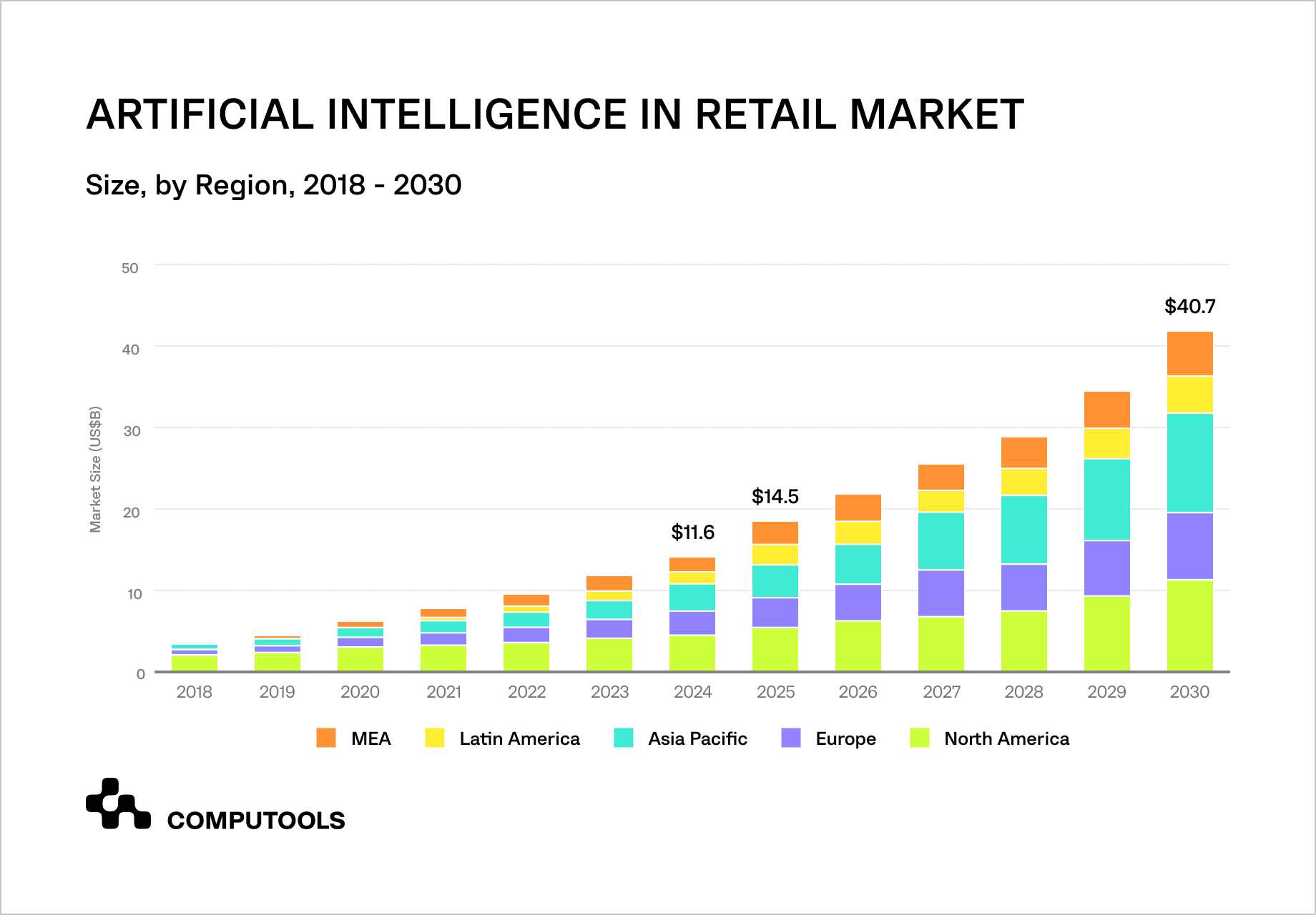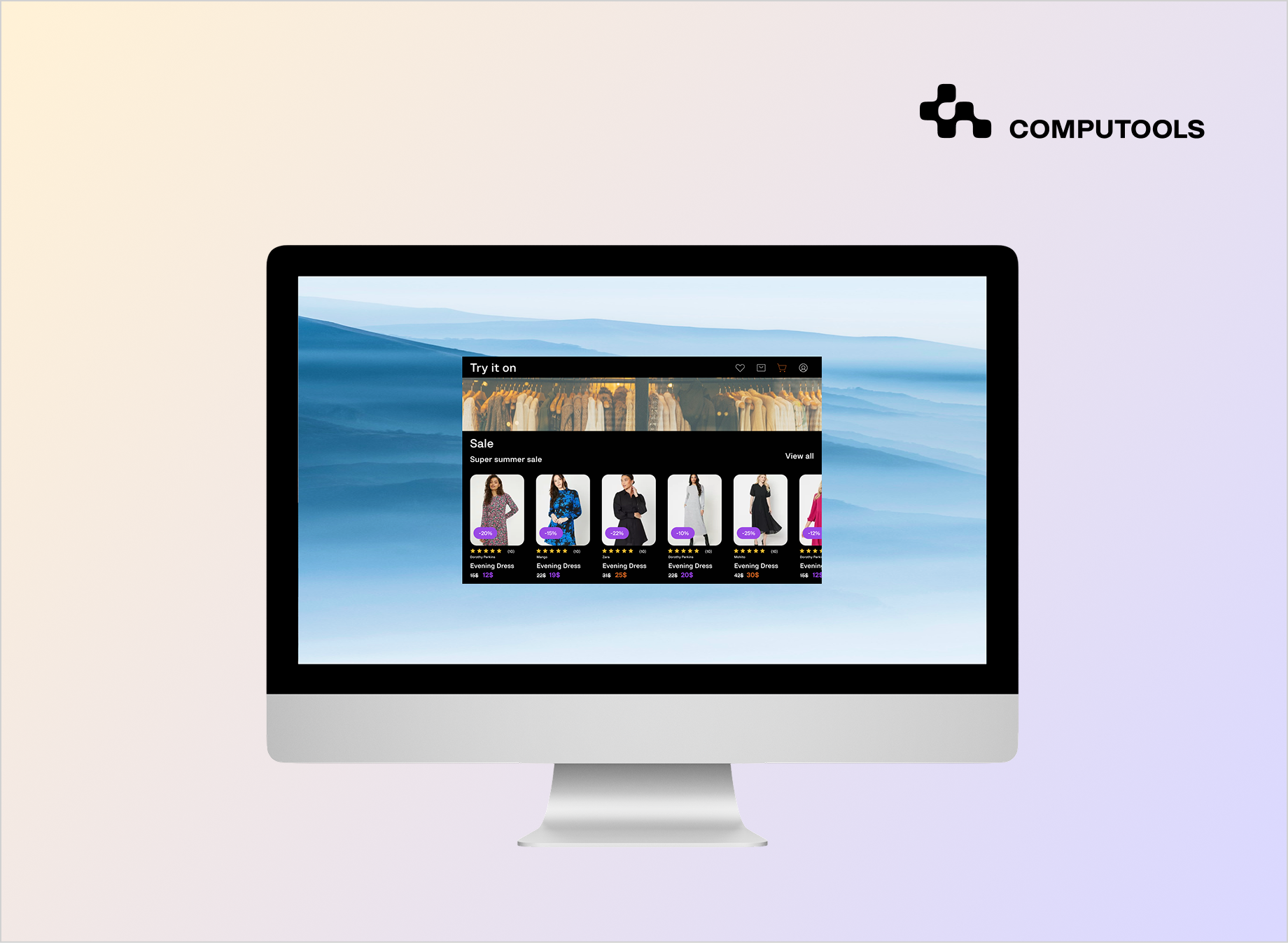AI is transforming retail at an incredibly rapid pace, and selecting the proper AI framework retail has become a defining success factor. The retail artificial intelligence market is projected to grow from $11.6 billion in 2024 to over $40 billion by 2030, driven by personalization, automation, and real-time analytics.
As retailers scale machine learning models for pricing, demand forecasting, and customer engagement, the decision between TensorFlow and PyTorch directly impacts development speed, scalability, and return on investment.

The challenge lies in selecting a framework that aligns with retail systems’ business logic, infrastructure, and data architecture. A successful framework should balance experimentation flexibility with production stability, impacting whether innovation yields measurable ROI.
Computools helps retail businesses bridge this gap through AI development services combining deep technical expertise and industry insight. Our team selects, integrates, and optimizes the right framework to match each project’s goals.
In one of our retail software development services projects, we implemented a deep learning pipeline that transformed raw retail data into actionable insights using TensorFlow’s robust production ecosystem and PyTorch’s experimental flexibility.
How we used TensorFlow and PyTorch in the TRY IT ON project
When developing TRY IT ON, Computools set an ambitious goal to make online shopping as realistic and reliable as in-store fitting. The project required a highly accurate virtual try-on engine capable of processing video and images in real time, adapting to various fabric textures, lighting conditions, and body types.
The challenge stood at the crossroads of computer vision, 3D modeling, and image analytics, and the combination of TensorFlow and PyTorch proved the perfect engineering solution.
Prototyping with PyTorch
During the research phase, PyTorch served as the primary tool for experimentation. Its dynamic computation graphs enabled engineers to modify neural network architectures quickly, testing various methods for 3D body reconstruction and texture overlay.
This adaptability enhanced clothing fit precision and motion rendering for different user body types. Using PyTorch’s real-time debugging and iteration features, our R&D team sped up model experimentation without lengthy recompilation.
This method reduced development cycles for AR features while preserving accuracy and performance.
Scaling, Production, and Mobile Optimization with TensorFlow
Once the models were stabilized, the system was migrated to TensorFlow for large-scale training, optimization, and cloud deployment. TensorFlow provided robust GPU acceleration, distributed learning, and reliable management of multiple environments simultaneously.
Through TensorFlow Lite, models were optimized for mobile devices, ensuring smooth real-time rendering, a critical factor for TRY IT ON’s user experience. TensorFlow Serving enabled centralized model updates with zero downtime, while TensorBoard supported transparent monitoring and visualization of training progress.
This double approach demonstrated how TensorFlow vs. PyTorch for retail can complement each other: PyTorch fueled experimentation and innovation, while TensorFlow delivered a production-ready, scalable system for eCommerce.
TRY IT ON became a vivid example of how an AI framework retail strategy can merge research agility with industrial reliability.
This hands-on experience is precisely why we’re writing this article. We don’t just analyze frameworks; we’ve tested, compared, and integrated them in real-world retail solutions. Working with TensorFlow and PyTorch gave us deep insight into how AI transforms retail into a data-driven, intelligent business ecosystem.
This project strengthened Computools’ expertise in eCommerce development services, unlocking a new level of intelligent retail software solutions where artificial intelligence drives personalization, automation, and measurable ROI.

How to choose the right AI framework: TensorFlow vs. PyTorch for retail applications
Today, AI helps stores predict demand, generate personalized recommendations, automate analytics, and reduce waste. However, the effectiveness of these solutions directly depends on the framework chosen.
AI framework comparison TensorFlow vs PyTorch for retail is a strategic choice between stability and flexibility, long-term scalability, and rapid innovation.
TensorFlow is a platform for those focusing on reliability, production-level, and continuous integration into business processes. PyTorch is a tool for teams that create, experiment, and test. For modern retail AI software development, it is important to understand how these approaches complement each other.
TensorFlow or PyTorch for AI framework retail projects?
Both are considered the best AI frameworks for retail industry, but their strength manifests at different product development stages. Let’s look closer.

1. Stage of Project Development
At the early stages, when businesses are testing ideas, creating MVPs, or validating hypotheses, PyTorch often proves more effective. Its dynamic computation graphs allow developers to modify model architectures on the fly, test new configurations, and debug faster without recompilation. This flexibility significantly accelerates experimentation and shortens time to market.
That’s how Computools approached the development of the TRY IT ON virtual fitting system. During the R&D phase, engineers relied on PyTorch to build and refine neural networks for 3D body reconstruction, fabric behavior, and lighting adaptation. The framework’s flexibility enabled realistic motion and texture effects while shortening development cycles.
Once the models stabilized, TensorFlow became the backbone for scaling. Its static graph architecture and GPU/TPU acceleration allowed efficient training on large datasets and seamless deployment in the cloud.

2. Type and Source of Data
TensorFlow performs best with structured data transaction histories, CRM records, POS data, and pricing analytics. It’s ideal for demand forecasting, stock optimization, and supply chain automation. Meanwhile, PyTorch shines when handling unstructured inputs like images, videos, and text, making it the go-to choice for computer vision, NLP, and generative AI applications.
Computools combined both frameworks to TRY IT ON to process diverse data streams. PyTorch handled user images and videos, powering real-time garment visualization, while TensorFlow processed structured catalog and profile data. The result was a personalized experience where computer vision met intelligent retail analytics.
3. Performance and Scalability
TensorFlow is built for enterprise-grade deployment. With distributed training, XLA compilation, and native integrations with Google Cloud, Kubernetes, and AWS, it maintains stability under heavy loads. PyTorch, by contrast, is highly adaptable and developer-friendly; you can rebuild layers, adjust loss functions, or test new parameters in just a few lines of code.
For TRY IT ON, this hybrid approach proved invaluable. PyTorch accelerated the creation of AR and 3D features, while TensorFlow powered model training and ensured stable real-time rendering in production. TensorFlow Lite made the app responsive even on mobile devices, a crucial factor for user experience and retention.
4. Product Goals and AI Strategy
When the goal is building AI in retail applications focused on demand forecasting, pricing, fraud detection, or operational automation, TensorFlow is typically the stronger choice. Its architecture handles large-scale data pipelines and supports production-grade predictive analytics in retail using AI.
For personalization, AR visualization, or generative experiences, PyTorch offers the agility needed for experimentation and fast iteration.

That’s precisely how Computools structured the TRY IT ON project. TensorFlow powered prediction accuracy and backend stability, while PyTorch enabled agile innovation in the visual and interactive layers. The outcome is an intelligent retail experience that adapts to each user in real time.
Computools’ experience proves that success in retail AI rarely comes from choosing a single framework. True efficiency lies in synergy: PyTorch accelerates innovation, while TensorFlow guarantees scalability and resilience. Together, they form the technological backbone for modern retail, where AI delivers measurable business growth and personalized customer engagement at scale.
Comparing TensorFlow and PyTorch for retail AI solutions
| Criteria | TensorFlow | PyTorch |
| Computation Graph Type | Static (Define-and-Run) with optional dynamic mode (Eager Execution) — stable and optimized for enterprise-scale systems | Dynamic (Define-by-Run) is ideal for flexible experimentation and real-time model modifications. |
| Development Flexibility | Requires a clearly defined architecture before execution, which enhances consistency in large retail systems. | Allows on-the-fly changes during training, perfect for agile retail machine learning development and innovation cycles. |
| Deployment Speed | Offers production-ready tools such as TensorFlow Serving, Lite, and JS, enabling seamless TensorFlow retail solutions across devices and platforms. | Provides flexibility with TorchServe, ONNX, and PyTorch Mobile, though deployment pipelines are less standardized. |
| Performance and Scalability | Built-in GPU/TPU acceleration, XLA compilation, and distributed training ensure robust scalability for AI framework retail environments. | Offers granular control and faster iteration speed, though large-scale automation requires additional setup. |
| Retail Use Cases | Excels in demand forecasting, dynamic pricing, and supply-chain analytics for large retail networks. | Supports generative content, AR try-ons, and NLP-based customer insights, areas where creative AI drives engagement. |
| Model Libraries | TensorFlow Hub is a stable, production-tested model repository ideal for enterprise deployment. | PyTorch Hub and Hugging Face’s vast libraries support fast R&D and experimentation in retail innovation. |
| Typical Applications | Predictive analytics, fraud detection, and recommendation systems built for consistency and scale. | Visual and text-based generative solutions, AR/VR experiences, and real-time personalization tools. |
| Community and Support | Backed by Google’s engineering ecosystem with long-term updates and enterprise-grade documentation. | Supported by the Linux Foundation with a dynamic open-source community fostering rapid advancements. |
The table clearly shows how both frameworks perform, but real retail innovation happens beyond specs. What truly matters is how TensorFlow and PyTorch evolve in practice and what new directions the AI framework retail ecosystem is taking next.
Choosing a skilled development partner is crucial for building apps that delight users and drive sales. This guide lists 20 Top-Rated Mobile App Development Firms for Retailers in 2025, highlighting strengths, locations, and focus areas.

Inventory, pricing, loyalty. AI touches it all. Learn which framework gives your retail business more control and better outcomes where it matters.
Pros and Cons for retail AI
Both frameworks have evolved far beyond their original purpose. When applied to retail, their trade-offs still define how fast a company can innovate and how reliably it can scale.
TensorFlow
• Pros: Enterprise-grade performance, strong integration with cloud ecosystems (Google Cloud, AWS), advanced deployment tools (TensorFlow Lite, Serving, TFX), and long-term stability for production.
• Cons: Less intuitive for experimentation, steeper learning curve, and slower iteration during the research phase.
PyTorch
• Pros: Dynamic computation graphs, faster prototyping, smoother debugging, strong support for NLP, computer vision, and generative AI.
• Cons: It requires additional setup for enterprise deployments and fewer native production pipelines than TensorFlow.
These trade-offs became a deliberate advantage in Computools’ TRY IT ON project: PyTorch fueled creativity and model experimentation for virtual try-ons. At the same time, TensorFlow delivered smooth deployment and cross-device scalability. This balance between flexibility and reliability defines the new generation of AI framework retail strategies, where innovation never compromises performance.
Emerging trends in AI frameworks
The competition between TensorFlow and PyTorch shows that ecosystems are evolving to support different sides of the retail innovation curve. In recent years, PyTorch has become the dominant framework in research, while TensorFlow continues to lead in enterprise-scale deployment.
Comparative studies show that PyTorch delivers up to 25% faster training and 77% faster inference than TensorFlow in benchmark CNN experiments. This growing divide highlights a simple truth: researchers use PyTorch for agility and experimentation, while enterprises rely on TensorFlow for scalability, compliance, and long-term reliability.
This split is shaping how deep learning frameworks for retail are used across the industry:
• PyTorch drives personalization, visual try-ons, and NLP-based customer engagement.
• TensorFlow powers predictive analytics, demand forecasting, and intelligent logistics.
In Computools’ TRY IT ON project, this duality became a strength. PyTorch accelerated experimentation with 3D body reconstruction and real-time texture mapping, the core of PyTorch retail applications. TensorFlow ensured these models could run efficiently across mobile devices, using TensorFlow Lite for seamless real-time rendering. Together, they created a fluid, AI-powered shopping experience that blurred the line between innovation and production.
What’s Next for Retail AI Development
The next generation of frameworks will continue to blur the boundaries between R&D and production. TensorFlow already adopts PyTorch-style dynamic execution, while PyTorch expands its reach with deployment tools like ONNX and TorchServe.
For retailers, this evolution signifies one thing: the future of AI involves convergence. The most forward-thinking brands no longer see the TensorFlow vs PyTorch comparison for AI retail projects as a rivalry, but as a roadmap for synergy, blending research agility with production-grade reliability. By integrating both ecosystems, they achieve faster prototyping, smoother deployment, and smarter decision-making across the supply chain.
This shift reflects a broader trend in AI technology for retail business process automation, where innovation is not limited to data science labs but flows directly into pricing engines, demand forecasting systems, and real-time personalization. At Computools, this principle underpins every AI solution we build, transforming innovation into measurable business growth.
Case studies and real-world applications
The real power of an AI framework retail strategy reveals itself in practice. Across industries, both PyTorch and TensorFlow prove how the right tools can reshape customer experiences and redefine efficiency.
PyTorch
Microsoft uses PyTorch for large-scale language modeling, enabling flexible transformer architectures like GPT.
Toyota applies it to real-time video analytics for autonomous vehicles, while Airbnb’s multilingual assistant enhances customer communication through PyTorch-based translation models.
In healthcare, Genentech leverages it for molecular simulations and personalized drug discovery.
TensorFlow
TensorFlow leads enterprise-scale AI model deployment for retail analytics, powering Google’s speech, image, and translation tools and driving pharmaceutical AI research at Novartis and Pfizer. In retail, TensorFlow enables demand forecasting, price optimization, and automated replenishment systems embedded directly in ERP and POS networks.
These examples illustrate an emerging reality: innovation doesn’t belong to one framework. How AI frameworks power retail automation and personalization becomes clear when both technologies work harmoniously — PyTorch teaches AI to imagine, while TensorFlow teaches it to endure. The future of retail AI will belong to those who know how to make both speak the same language, turning experimentation into evolution.
Why choose Computools
Every successful retail transformation starts with a clear strategy. At Computools, we help brands translate business vision into intelligent systems that evolve, adapt, and perform.
In our TRY IT ON project for a fashion retailer, we transformed online shopping into a dynamic, personalized experience. By combining PyTorch’s agility for 3D body reconstruction with TensorFlow’s scalability for real-time rendering, we built a virtual fitting solution that increased online sales by 20% and reduced product returns by 30%.
This project became a benchmark for fashion software development, proving how AI can bridge creativity and commerce.

Every Computools project carries that same intent: to make technology invisible and impact undeniable. If you’re ready to reimagine what’s possible for your retail business, let’s build it together. Reach us at info@computools.com
To sum up
In retail, choosing the best AI framework for retail projects comes down to matching speed with stability. PyTorch helps ideas take shape fast; TensorFlow keeps them running at scale. Together, they turn innovation from a lab experiment into real customer experiences.

Computools
Software Solutions
Computools is a digital consulting and software development company that delivers innovative solutions to help businesses unlock tomorrow.









“Computools was selected through an RFP process. They were shortlisted and selected from between 5 other suppliers. Computools has worked thoroughly and timely to solve all security issues and launch as agreed. Their expertise is impressive.”